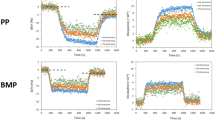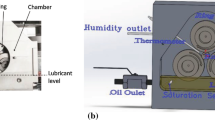Abstract
Prior research with zinc dialkyl dithiophosphate (ZDDP) additive has shown that higher relative humidity can result in higher wear. In order to validate this phenomenon, a phosphoric additive was added to the same base oil as previous studies to explore the effect of relative humidity and water on the related tribological performances in pure sliding contacts. The post-test specimen surfaces were examined under scanning electron microscope to study the effect of relative humidity on the surface, followed by applying x-ray photoelectron spectroscopy to study the related tribochemistry behavior. It is clear that higher relative humidity results in higher wear. Oxygen concentration as oxide in the wear scar increases with the increase in relative humidity. The reaction layer thickness decreases with the increase in relative humidity, which leads to more asperity contacts and results in higher wear on the ball surface.


Reprinted from Wolfe (Ref 24), with permission from Elsevier








Similar content being viewed by others

References
B.J. Fitch and S. Jaggernauth, Moisture, the Second Most Destructive Lubricant Contaminant, and Its Effects on Bearing Life, P/PM Technol., 1994, 5, p 50–53
M. Day and C. Bauer, Water Contamination in Hydraulic and Lube Systems, Pract. Oil Anal., 2007, 9, p 2007
R.M. Gresham, When Oil and Water Do Mix, Tribol. Lubr. Technol., 2008, 64(3), p 22
D. Troyer, The Visual Crackle-A New Twist to an Old Technique, Pract. Oil Anal. Mag., 1998, 10, p 14–17
W.M. Needelman, M.A. Barris, and G.L. Lavallee, Contamination Control for Wind Turbine Gearboxes, Power Eng. (Barrington, Illinois), 2009, 113(11), p 112–120
M. Duncanson, Machinery Lubrication: Detecting and Controlling Water in Oil, Pract. Oil Anal., 2005, 9, p 20–21
J.K. Lancaster, A Review of the Influence of Environmental Humidity and Water on Friction, Lubrication and Wear, Tribol. Int., 1990, 23(6), p 371–389
Z. Chen, X. He, C. Xiao, and S.H. Kim, Effect of Humidity on Friction and Wear-A Critical Review, Lubricants, 2018, 6(3), p 1–26
L. Grunberg and D. Scott, The Acceleration of Pitting Failure by Water in the Lubricant, J. Inst. Pet., 1958, 44(419), p 406–410
P. Schatzberg and I.M. Felsen, Effects of Water and Oxygen during Rolling Contact Lubrication, Wear, 1968, 12(5), p 331–342
E.L. Armstrong, S.J. Leonardi, W.R. Murphy, and P.S. Wooding, Evaluation of Water-Accelerated Bearing Fatigue in Oil-Lubricated Ball Bearings, Lubric. Eng., 1978, 34(1), p 15–21
V. Brizmer, H.R. Pasaribu, and G.E. Morales-Espejel, Micropitting Performance of Oil Additives in Lubricated Rolling Contacts, Tribol. Trans., 2013, 56(5), p 739–748
E. Harika, J. Bouyer, M. Fillon, and M. Hélène, Measurements of Lubrication Characteristics of a Tilting Pad Thrust Bearing Disturbed by a Water-Contaminated Lubricant, Proc. Inst. Mech. Eng. Part J J. Eng. Tribol., 2013, 227(1), p 16–25
E. Harika, J. Bouyer, M. Fillon, and M. Hélène, Effects of Water Contamination of Lubricants on Hydrodynamic Lubrication: Rheological and Thermal Modeling, J. Tribol., 2013, 135(4), p 1–10
A.C. Gonçalves and L.R. Padovese, Vibration and Oil Analysis for Monitoring Problems Related to Water Contamination in Rolling, Proceedings-International Brazilian Conference on Tribology, 2010, p 80–90.
I. Nedelcu, E. Piras, A. Rossi, and H.R. Pasaribu, XPS Analysis on the Influence of Water on the Evolution of Zinc Dialkyldithiophosphate-Derived Reaction Layer in Lubricated Rolling Contacts, Surf. Interface Anal., 2012, 44(8), p 1219–1224. https://doi.org/10.1002/sia.4853
H. Cen, A. Morina, A. Neville, R. Pasaribu, and I. Nedelcu, Effect of Water on ZDDP Anti-Wear Performance and Related Tribochemistry in Lubricated Steel/Steel Pure Sliding Contacts, Tribol. Int., 2012, 56, p 47–57. https://doi.org/10.1016/j.triboint.2012.06.011
H. Cen, A. Morina, and A. Neville, Effect of Ageing on Lubricants’ Physical and Chemical Properties and Tribological Performance: Part II: Effect of Water Contamination on Lubricant, Ind. Lubr. Tribol., 2019, 71(1), p 48–53
P. Parsaeian, A. Ghanbarzadeh, M. Wilson, M.C.P. Van Eijk, I. Nedelcu, D. Dowson, A. Neville, and A. Morina, An Experimental and Analytical Study of the Effect of Water and Its Tribochemistry on the Tribocorrosive Wear of Boundary Lubricated Systems with ZDDP-Containing Oil, Wear, 2016, 358–359, p 23–31. https://doi.org/10.1016/j.wear.2016.03.017
P. Parsaeian, A. Ghanbarzadeh, M.C.P. Van Eijk, I. Nedelcu, A. Morina, and A. Neville, Study of the Interfacial Mechanism of ZDDP Tribofilm in Humid Environment and Its Effect on Tribochemical Wear, Part II: Numerical, Tribol. Int., 2017, 107((November 2016)), p 33–38. https://doi.org/10.1016/j.triboint.2016.11.015
S. Soltanahmadi, A. Morina, M.C.P. van Eijk, I. Nedelcu, and A. Neville, Tribochemical Study of Micropitting in Tribocorrosive Lubricated Contacts: The Influence of Water and Relative Humidity, Tribol. Int., 2017, 107(August 2016), p 184–198
H. Cen, A. Morina, and A. Neville, Effect of Slide to Roll Ratio on the Micropitting Behaviour in Rolling-Sliding Contacts Lubricated with ZDDP-Containing Lubricants, Tribol. Int., 2018, 122, p 210–217. https://doi.org/10.1016/j.triboint.2018.02.038
H. Cen, A. Morina, and A. Neville, Effect of Base Oil Polarity on the Micropitting Behaviour in Rolling-Sliding Contacts, Lubr. Sci., 2019, https://doi.org/10.1002/ls.1453
N.L. Wolfe, Organophosphate and Organophosphorothionate Esters: Application of Linear Free Energy Relationships to Estimate Hydrolysis Rate Constants for Use in Environmental Fate Assessment, Chemosphere, 1980, 9(9), p 571–579. https://doi.org/10.1016/0045-6535(80)90075-2
Y. Arai and D.L. Sparks, ATR-FTIR Spectroscopic Investigation on Phosphate Adsorption Mechanisms at the Ferrihydrite-Water Interface, J. Colloid Interface Sci., 2001, 241(2), p 317–326
F.J. Archard, Elastic Deformation and the Contact of Surfaces, Nature, 1953, 172(4385), p 918–919
J.M. Martin, Antiwear Mechanisms of Zinc Dithiophosphate: A Chemical Hardness Approach, Tribol. Lett., 1999, 6(1), p 1–8
S. Soltanahmadi, A. Morina, M.C.P. Van-Eijk, I. Nedelcu, and A. Neville, Investigation of the Effect of a Diamine-Based Friction Modifier on Micropitting and the Properties of Tribofilms in Rolling-Sliding Contacts, J. Phys. D. Appl. Phys., 2016, 49(50), p 505302. https://doi.org/10.1088/0022-3727/49/50/505302
Y. Shimizu and H.A. Spikes, The Influence of Slide-Roll Ratio on ZDDP Tribofilm Formation, Tribol. Lett., 2016, 64(2), p 19. https://doi.org/10.1007/s11249-016-0738-z
M.A. Nicholls, T. Do, P.R. Norton, M. Kasrai, and G.M. Bancroft, Review of the Lubrication of Metallic Surfaces by Zinc Dialkyl-Dithiophosphates, Tribol. Int., 2005, 38(1), p 15–39. https://doi.org/10.1016/j.triboint.2004.05.009
T.L. Krantz and A. Kahraman, An Experimental Investigation of the Influence of the Lubricant Viscosity and Additives on Gear Wear, Tribol. Trans., 2004, 47(1), p 138–148
Acknowledgments
The authors would like to thank the financial support by National Natural Science Foundation of China (Grant No. 51905463) as well as the outstanding young core teacher program of Xuchang University.
Author information
Authors and Affiliations
Corresponding author
Additional information
Publisher's Note
Springer Nature remains neutral with regard to jurisdictional claims in published maps and institutional affiliations.
Rights and permissions
About this article
Cite this article
Cen, H., Bai, D., Chao, Y. et al. Effect of Relative Humidity on the Tribological Performance of Pure Sliding Contacts Lubricated with Phosphorus Additive Containing Lubricants. J. of Materi Eng and Perform 29, 4786–4793 (2020). https://doi.org/10.1007/s11665-020-04977-6
Received:
Revised:
Published:
Issue Date:
DOI: https://doi.org/10.1007/s11665-020-04977-6



